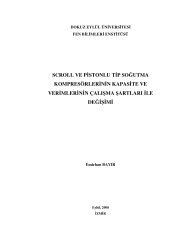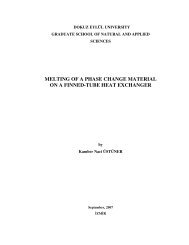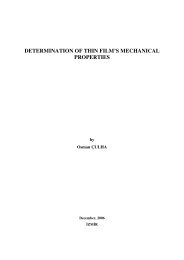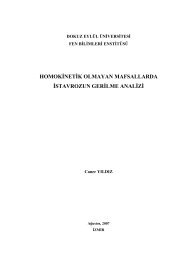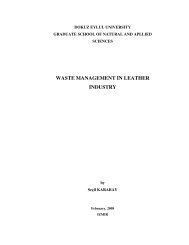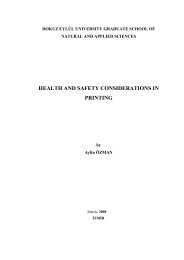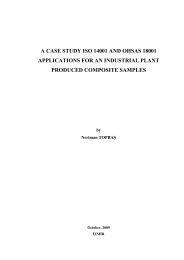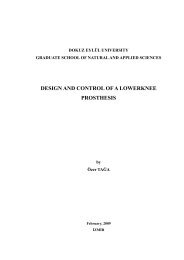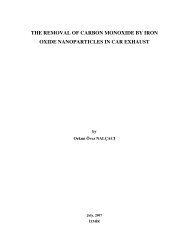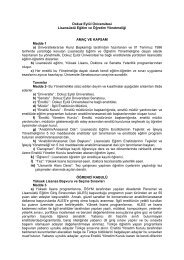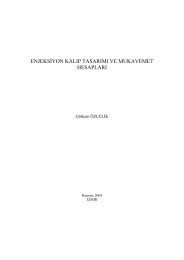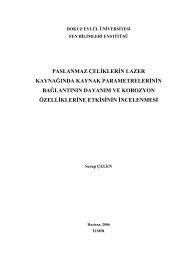FIRST FAILURE PRESSURE OF COMPOSITE PRESSURE VESSELS
FIRST FAILURE PRESSURE OF COMPOSITE PRESSURE VESSELS
FIRST FAILURE PRESSURE OF COMPOSITE PRESSURE VESSELS
Create successful ePaper yourself
Turn your PDF publications into a flip-book with our unique Google optimized e-Paper software.
DOKUZ EYLÜL UNIVERSITYGRADUATE SCHOOL <strong>OF</strong> NATURAL AND APPLIED SCIENCES<strong>FIRST</strong> <strong>FAILURE</strong> <strong>PRESSURE</strong> <strong>OF</strong> <strong>COMPOSITE</strong><strong>PRESSURE</strong> <strong>VESSELS</strong>byAziz ÖNDERFebruary, 2007İZMİR
<strong>FIRST</strong> <strong>FAILURE</strong> <strong>PRESSURE</strong> <strong>OF</strong> <strong>COMPOSITE</strong> <strong>PRESSURE</strong> <strong>VESSELS</strong>ABSTRACTIn this study, optimal angle-ply orientations of symmetric and antisymmetric [ θ / −θ]shells designed for maximum burst pressure were investigated. Burst pressure of filamentwound composite pressure vessels under alternating pure internal pressure has beeninvestigated. The cylindrical section of composite pressure vessels is conducted. A finiteelement method and experimental approaches are studied to verify optimum winding angles.Glass reinforced plastic (GRP) pipes are made of E-glass epoxy and tested closed-endcondition. For this study, a PLC controlled hydraulic pressure testing machine has beenestablished. Study deals with the influences of winding angle on filament-wound compositepressure vessel. An elastic solution procedure based on the Lekhnitskii’s theory wasdeveloped in order to predict the first-ply failure of the pressure vessels. The Tsai-Wu failurecriterion is applied for the checking the first-ply failure of layers in a simple form. Thesolution is presented and discussed for various orientation angles. Test specimens have fourlayers, which have various orientation angles. The layers are oriented symmetrically andantisymmetrically for,o o[45 /-45 ]s,o o[55 /-55 ]s,o o[60 /-60 ]s,o o[75 /-75 ]sando o[88 /-88 ]sorientations. The hygrothermal and other mechanical properties are measured on an E-glass-epoxy composite layer. Some analytical and experimental solutions are compared withthe finite element solutions, in which commercial software ANSYS 10.0 was utilized, andclose results are obtained between them. The optimum winding angle for the compositepressure vessel analysis with the internal pressure loading case is obtained as [55 ]laminates and as [90 ]for a lamina.sforKeywords: Composite pressure vessels, filament winding, finite element analysis, internalpressure
KOMPOZİT BASINÇLI TÜPLERDE İLK HASAR BASINCIÖZBu çalışmada, simetrik ve antisimetrik [ θ / −θ /...] şeklindeki tabakalı ince cidarlıkompozitlerin maksimum patlama basıncı için en uygun tabaka-açı oryantasyonları araştırıldı.Kompozit basınçlı tüpün içten basınca maruz olması durumundaki davranışı incelenmiştir.Kompozit basınçlı tüplerin silindirik kısmına değinilmiştir. Sonlu elemanlar metodu vedeneysel çalışmalarla en uygun sarım açısı saptanmaya çalışılmıştır. E-cam/epoksi CTPborular üretilmiş ve kapalı uçlu iç statik basınç testleri uygulanmıştır. Bu çalışma için PLCkontrollü hidrolik basınç test cihazı kuruldu. Çalışmada filaman sarımlı kompozit tüplerüzerindeki sarım açılarının etkileri ele alınmıştır. Kompozit tüpte oluşan hasarı belirlemekiçin nümerik çözüm yöntemi Lekhnitskii teorisi kullanılarak geliştirilmiştir. Bu yöntemlehasar basıncı aynı ısı etkisi ile değişik açı oryantasyonlarında hesaplanmıştır. Tsai-Wu hasarkriteri tabakalarda oluşan hasarın kontrolünde uygulanmaktadır. Test numuneleri dörttabakalı ve çeşitli oryantasyon açılarına sahiptir. Tabakalar simetrik ve antisimetrik durumunagöre,o oo oo oo oo o[45 /-45 ]s, [55 /-55 ]s, [60 /-60 ]s, [75 /-75 ]sand [88 /-88 ]saçıoryantasyonlarında ele alınmaktadır. Kompozit malzeme olarak E-cam epoksi seçilmiş ve bumalzemenin termal ve mekanik özellikleri hesaplamalarda kullanılmaktadır. Bazı nümeriksonuçlar sonlu elemanlar programı ANSYS 10.0 sonuçları ile karşılaştırılmakta ve yakındeğerler elde edilmektedir. İçten basınca maruz helisel açıda sarımlı kompozit tüplerde enuygun sarım açısının 55 o civarında olduğu tespit edilmekte, tek açıda sarımlı kompozit tüpleriçin ise bu değer 90 o olarak bulunmaktadır.sAnahtar sözcükler: Kompozit basınçlı tüpler, filaman sargı, sonlu elemanlar analizi, içbasınç1.IntroductionPressure vessels have been manufactured by filament winding for a long time. Althoughthey appear to be simple structures, pressure vessels are among the most difficult to design.Filament-wound composite pressure vessels have found widespread use not only for military
use but also for civilian applications. This technology originally developed for the military’sinternal use was adapted to civilian purpose and later extended to the commercial market.Applications include breathing device, such as self-contained breathing apparatuses used byfire-fighters and other emergency personnel, scuba tanks for divers, oxygen cylinders formedical and aviation cylinders for emergency slide inflation, opening doors or lowering oflanding gear, mountaineering expedition equipment, paintball gas cylinders, etc. A potentialwidespread application for composite pressure vessels is the automotive industry. Emphasison reducing emissions promotes the conversion to Compressed Natural Gas (CNG) fuelledvehicles worldwide. Engineers are seeking to replace fuel oils with natural gas or hydrogen asthe energy supply in automobiles for air quality improvements and reduce global warning.Fuel cells in concert with hydrogen gas storage technologies are key requirements for thesuccessful application of these fuels in vehicles. One of the limitations is lack of vehicle rangebetween refuelling stops. Weight, volume and cost of the containment vessel are alsoconsiderations.The pressure containment limits of thin wall composite vessels are currently insufficientfor their broad application in the transportation industry. Further development of thick-walleddesigns is required in order to hold ultra-high pressure fuel gases. It is known that stressdecline rapidly through the wall thickness. At first glance pretension of wound fibers appearsto be able to change the distribution of stress through the wall thickness, but research hasshown that the effects are limited. Optimization of stress distributions through a variation ofgeometry is considered in the design stages of pressure vessels. Stress distributions throughthe thickness in pressure vessels appear to be not sensitive to geometry modifications. As hasbeen pointed out, the current ultra high pressure vessels are low in structural efficiency. Therealso exists a fundamental lack of confidence in the ability to understand and predict theirbehaviours.Most of finite element analyses on composite pressure vessels are based on shell elementswhich are generated using the classical lamination theory. The results should be good whenthe internal pressures are not very high and ratio of diameter to wall thickness is greater than15. Some FEA tools like ANSYS provide a thick shell element to reflect the influence ofshear stress in the radial direction and capture the transverse shear deformation.
Composite pressure vessels should take full advantage of the extremely high tensilestrength and high elastic modulus of the fibers from which they are made. Theories oflaminated composite materials for evaluating these properties are relatively well establishedfor modulus, and to a lesser extent for strength.From the literature review; it was found that most of design and analysis of compositepressure vessels are based on thin-walled vessels. As pointed out earlier, when the ratio of theoutside diameter to inside diameter is larger than 1.1, the vessel should be considered thickwalled.Only a few researchers have considered the effect of wall thickness.The solution of composite cylinders is based on the Lekhnitskii's theory (1981). Heinvestigated the plane strain case or the generalized plane strain cases. Roy and Tsai (1988)proposed a simple and efficient design method for thick composite cylinders; the stressanalysis is based on 3-dimensional elasticity by considering the cylinder in the state ofgeneralized plane strain for both open-ended (pipes) and closed-end (pressure vessel).Sayman (2005) studied analysis of multi-layered composite cylinders under hygrothermalloading. Mackerle (2002) gives a bibliographical review of finite element methods applied forthe analysis of pressure vessel structures and piping from the theoretical as well as practicalpoints of view. Xia et al. (2001) studied multi-layered filament-wound composite pipes underinternal pressure. Xia et al. (2001) presented an exact solution for multi-layered filamentwoundcomposite pipes with resin core under pure bending. Rao and Sinha (2004) studied theeffects of temperature and moisture on the free vibration and transient response ofmultidirectional composites. A three-dimensional finite element analysis is developed for thesolution.Parnas and Katırcı (2002) discussed the design of fiber-reinforced composite pressurevessels under various loading conditions based on a linear elasticity solution of the thickwalledmultilayered filament wound cylindrical shell. A cylindrical shell having number ofsublayers, each of which is cylindrically orthotropic, is treated as in the state of plane strain.
Literature reveals that:• Most of the finite element analyses of composite pressure vessels are based onelastic constitutive relations and traditional thin-walled laminated shell theory• Optimization of composite pressure vessels is done by changing the parameters of thecomposite materials including filament winding angle, lamination sequence, andmaterial• A Tsai-Wu failure criterion is regarded to be one of the best theories at predictingfailure in composite materialThe present research focuses on:• Determination of first failure pressures of composite pressure vessels by using a finiteelement method• Optimization of composite pressure vessels• Comparison of filament winding angles of composite pressure vessels• Comparison of theoretical results with experimental2. Theoretical and Experimental Studies2.1 Numerical StudyProperties of composite materials, as well as properties of all structural materials areaffected by environmental and operational conditions. Moreover, for polymeric compositesthis influence is more pronounced than for conventional metal alloys because polymers aremore sensitive to temperature, moisture, and time than metals. There exists also a specificfeature of composites associated with the fact that they do not exist apart from compositestructures and are formed while these structures are fabricated. As a result, materialcharacteristics depend on the type and parameters of the manufacturing process, e.g.,unidirectional composites made by pultrusion, hand lay-up, and filament winding candemonstrate different properties.
Figure 2 Principal material directionsFor an axially symmetric case, the shear stresses τ rθ and τ rz are equal to zero. τ θz is alsoequal to zero because there is no twisting moment applied to the cylinder. The stress-strainrelation for the axially symmetric case, as shown in Figure 2, can be written as,In this case, the strain-stress relations in a composite vessel can be written in terms of thecompliance matrix;ε = a σ + a σ + a σ + α T + β cr rr r rθθ rz z r rε = a σ + a σ + a σ + α T + β c (2)θ rθ r θθ θ θz z θ θε = a σ + a σ + a σ + α T + β cz rz r θz θ zz z z zwhere αr, αθ,αzare the thermal expansion coefficients and β r, βθ,β zand c are hygroscopicexpansion coefficients and moisture concentration.The hygrothermal stresses are obtained by using a parameter, Cε = a σ + a σ + a σ + α T + β c = Cz rz r θz θ zz z z zC a a α βσz= - σ - σ - T - c (3)a a a a arz θzz zrθzz zz zz zz zzWhenσzsubstituted into relations is εr and θε becomes as,
∂uCεr= =βrrσ r+ βr θσ θ+ α rT + βrc + arz,∂ra1∂νu Cεθ= + =βr θσ r+ βθθσ θ+ α θT + βθc + aθzr ∂θ r azzzz(4)whereaa aaβ = a − , β = a − , β = a − ,22rzθz rz θzrr rr rθ rθ θθ θθazz azz azzaaβ a=α − β =β − βz rz z rzrz θzar r,r r,d= (5)azz azz azzaaβ a=α − β =β − z θβz , βdd0=a βz θzaθ θ,θ θazzzzaθθ− aβ coefficient of hygroscopic expansionc moisture concentrationA stress function (F) under the Lekhnitskii’s theory can be written as∂ ∂σ = + = , σ =(6)2 21 F 1 F 1dF d Fr 2 2 θ 2r ∂r r ∂θr dr drWriting εr= du / dr and ε = u / r for an axially symmetric case gives the compatibilityequation. By differentiating ufollowing,θ= rε θwith respect to r, the compatibility equation is obtained asdudrdε=εθ+ rdrθthen,dεθεr=εθ+ r (7)drWhen the compatibility equation is used between ε rand ε θ, an ordinary differentialequation is obtained for the stress function F as,
3 23 d F 2 d F dF 2 2 3 dT 2r βθθ+ r β3 θθ−rβ 2 rr= Tr ( αr−α θ) + cr ( βr−βθ) −α θr + Cr βd(8)dr dr dr dr3 23 d F 2 d F 2 dF 2 2 3 dT 2r + r − rk = Tr α ′3 21+ cr β′1−α θr + Cr βd(9)dr dr dr drwhereββrrθθ= α −α =α′ β −β =β′2k, ( r θ) 1, (r θ)1The Equation (9) is solved by using the transformation of F = r α . Uniform temperaturedistribution is chosen in the solution and we have2 3dT α−1 d F α−2 d Fα−3=α r , =α( α− 1)r , =α( α−1)( α− 2)r(10)2 3dr dr drPut Equation (10) into Equation (9) we get characteristic equationα α α 2r αα− ( 1)( α− 2) + r αα− ( 1) −r k α= 0α2r[ αα− ( 1)( α− 2) +αα− ( 1) −k α ] = 0(11)Here2r α ≠0, k ≠ 0 andα α− α− + α− − =2[( 1)( 2) ( 1) k ] 0αα − α+ − =2 2( 2 1 k ) 0(12)Roots of Equation (12) are foundα = 01α = 1+k (13)2α = 1−k3So we get homogeneous solution of differential problemF = C r + C r + C rα1 α2 α1h 0 1 2F = C + C r + C r1+ k 1−kh 0 1 2(14)
Tα+ ′ crβ+ ′ Cβ2(1 − k )1 1 d 2Fp =r (20)2Put Equations (20) and (14) into Equation (15) the stress function F is obtained as,1+ k 1− k Tα+ ′1crβ+ ′1Cβd2F = C0 + C1r + C2r +r (21)22(1 − k )The stress components are obtained as,1dF k 1 k 1 T1cr1Cdr (1 k)C1 r− (1 k)C2 r− − α ′ + β ′ + βσ = = + + − +2 ,rdr (1−k)Tα ′ + crβ ′ + Cβσθ= = + − − +dr (1 − k )2dF k 1 k 1 1 1 d2 k(1 k)C1 r− k(1 k)C2 r− −2 ,C a + ka − a + kaσ =− − (1+ k)C r + (1−k)C rrz θz k−1 rz θz−k−1z 1 2azz azz azza2A+ a αTβrz θz z− −0− zazzazzazzc(22)Radial displacement is obtained from the relationu = ( β + k β )(1+ k)C r + ( β −k β )(1−k)rkrθ θθ 1 rθ θθa+ β +β +α +β +θz2(rθθθ)Ar θT0r θcr Crazz−kuεθ= then u is written as,r(23)The integration constants obtained in this solution for each layer are C 1 and C 2 . If the totalnumber of layers is n, the total number of the unknown integration constants is 2xn.They are calculated by using the boundary conditions. If the vessel is subjected to internalpressure at the inner surface is free at the outer surface, the boundary conditions are writtenas,σ r = -p at the inner surface, r = aσ r = 0 at the outer surface, r = b (24)where a and b are the inner and outer radii of the composite vessel. However, the number ofboundary conditions can be written is (2× n) − 2. The radial stress (σ r ) and radial
2.2 Finite Element ApproachIn this section, by using ANSYS 10.0 finite element analysis software, a staticfailure analysis was performed on an element of a composite pressure vessel in Figure 4.According to thin-walled assumptions the stress of the pressure vessel subjected to internalpressure p can be given asσ =hoopσ =longpRtpR2t(27)In addition, parametric studies have been performed using various orientation angles. Thefirst failure pressure was studied on this solution method.In this study, maximum failure pressure value was found by finite element analysis usingANSYS. In order to model the problem, a small element was taken from on the pressurevessel which is shown in Figure 4. This element was modeled using ANSYS and someoperation was done respectively in the below.Figure 4 Element of a composite pressure vessel.First element type was defined with solid layered 46 in Figure 5. Solid46 is a layeredversion of the 8-node structural solid element designed to model layered thick shells or solids.The element allows up to 250 different material layers. The element may also be stacked asan alternative approach. The element has three degrees of freedom at each node: translationsin the nodal x, y, and z directions.
Figure 5 SOLID46 geometry.Real constant sets were defined for 4 layers, various orientation angles and each layersthickness was entered 0.6 mm Figure 6.Figure 6 Sample layplot display for [45/-45/ - 45/45] sequence.After material properties was defined, linear orthotropic material was chosen and themechanical properties of E-glass/epoxy composite material was added as EX, EY, EZ, PRXY,PRYZ, PRXZ, GXY, GYZ and GXZ.In order to calculate failure criteria, ultimate tensile strength, compressive strength andshear strength were entered both in fiber direction and in matrix direction.
Then a volume block was modeled and material properties, real constant sets and elementtype were appointed to the volume. After that the model was meshed by using hexahedralsweeped elements Figure 7.Figure 7. Finite element mesh.Boundary conditions were defined to corresponding to each side surfaces by usingloads→pressure on areas functions as shown in Figure 8.Then analysis was run and the solutions were observed with plot results→nodalsolutions→failure criteria→Tsai-Wu strength index. Failure criteria value was made equal to1 by changed boundary conditions pressure value. Then this pressure values was substitutedas a stresses in Equation (27) to calculate burst pressure of the composite pressure vessel.Figure 8 Finite element boundary conditions
L = 400 mmD = 110 mma = 20 mmb = 6 mmc = 15 mmd = 100 mme = 60 mmt = 1.6 mmφ = winding angleTable 2. Stacking sequences of specimens.Type Ply angle ( )SYMMETRICALANTISYMMETRICAL[±Ф]s[±Ф]2A [ + 45/ −45/ − 45/ + 45]B [ + 55/ −55/ − 55/ + 55]C [ + 60 / −60 / − 60 / + 60]D [ + 75/ −75/ − 75/ + 75]E [ + 88/ −88/ − 88/ + 88]F [ + 45/ − 45/ + 45/ − 45]G [ + 55/ − 55/ + 55/ − 55]H [ + 60 / − 60 / + 60 / − 60]I [ + 75/ − 75/ + 75/ − 75]J [ + 88/ − 88/ + 88/ − 88]Determination of Mechanical PropertiesMechanical tests are applied to determine the engineering constants. Two strain gauges arelocated are located in the directions 1 and 2. In this way, the modulus of elasticity, E1andPoisson’s ratio, ν 12are determined. The test specimen is loaded by Instron-1114 TensileMachine. The modulus of elasticity in the transverse direction E 2is measured by usinganother strain gauge. A strain gauge is located on test specimens; the fibers are oriented 45 degrees with respect to loading direction.measurements, εx. G12is computed fromE xis measured form the strain gauge
1G12=(28)4 1 1 2ν12− − −E E E Ex 1 2 1Figure 10 shows Iosipescu test method which is used to find the shear strength S. It iscomputed from= P maxStcIn addition, the strength in the first and second principal material directions is computed.They areXtandY tfor tensile strengths andXcandY cfor compressive strengths. Themechanical properties in the third principal direction are assumed to be equal to those in thesecond principal direction.Thermal expansion coefficients in the principal material directions are measured by straingauges. For this measurement, temperature is increased step by step, and then thestrains in the principal material directions are determined. The thermal expansioncoefficients are calculated from the strains in the principal material directions.The strain gauges are isolated from water and the test specimens are put into the water inorder to measure the hygrothermal coefficients. Therefore, the specimen is waited for twohours (based on the ASTM standards), at 23 C , in the water in order to enable waterabsorption by the composite material. The coefficients of the hygrothermal expansion andmoisture concentration are measured from the test specimens in the principal materialdirections asβ 1, β2and c, respectively. Mechanical properties of composite material areshown in Table 3.Table 3. Mechanical properties of composite material.E 1 (MPa) E 2 (MPa) G 12 (MPa) ν 12 X t (Mpa) Y t (MPa) X c (MPa)36514 14948 6350 0,24 938 89 938Y c (MPa) S(MPa) α 1 (1/ o C) α 2 (1/ o C) β 1 β 2153 88 7,52x10 -6 47,77x10 -6 -46x10 -4 14x10 -4
Figure 10 Iosipescu test method.Setting Experimental EquipmentsFigure 11 shows closed end internal pressure test apparatus for GRP pipe. Figure 13shows details of test apparatus.Figure 11. Closed-end internal pressure test apparatus.Specimens were exposed to closed end internal pressure tests using the instrument designshown in Figure 11.
Figure 12 A photograph of test apparatus.Static internal pressure tests were conducted using a 250 bar PLC controlled servohydraulictesting machine. The procedure for determining burst pressure of compositepressure vessel is based on ASTM standard. Test specimens were loaded with internalpressure to burst pressure using a 1 MPa/min loading rate. Figure 14 shows a PLC controlledservo-hydraulic testing machine.Figure 13. Details of test apparatus.A = Composite pressure vesselB, D = Compressing parts
C = Rubber seal elementE = System locking member componentF = FlangeG = NutFigure 14 A PLC controlled servo-hydraulic testing machine.A protective test box was manufactured for observing the test specimen during pressuretests. It provides taking photo and video easily and protects harmful effects of hydraulic oil.3. Results and DiscussionsIn this study, three different methods were used to determine first failure pressure ofcomposite pressure vessels. Analytical method, finite element method and experimentalmethod were applied respectively.A glass-epoxy composite layer is used in the solution. The layers are orientedsymmetrically or antisymmetrically. The Tsai-Wu criterion is used to compute the first failurepressure of the composite layers in a simple form.In order to see how structures behave, the theoretical results are necessary for a givenmaterial, geometry and loading combination. A computer program is developed withMATEMATICA and FORTRAN using the derived formulation of the stresses. In order todetermine the burst pressure, the performance of the specified composite pressure vessel is
taken as the only limiting value. Burst pressure determined by using the first-ply failurecriterion.The design outputs of the computer program are optimum winding angle, burst pressure,geometry and loading combination. Also the effect of the hygrothermal forces on the burstpressure is studied.In the literature, the optimum winding angle for filament wound composite pressurevessels is given as 54.74 o by netting analysis. Using the current procedure for the internalpressure loading, the optimum winding angle is obtained as 61 o for laminates composites andas 90 o for a lamina (the winding angle is assumed to be only positive). In order to decide theoptimum winding angle, the winding angle was chosen between 0 o and 90 0 and each anglewas computed with a step size of 1 o via computer program and was calculated burst pressureboth symmetrically and antisymmetrically conditions. These results are given in Figure 16,Figure 17 and Figure 18. Numerical solutions are studied symmetrical and antisymmetricalconditions for the orientation angle of 45 0 , 55 0 , 60 0 , 75 0 and 88 0 at different temperatures. Inthe analytical solutions the temperatures influence is found ineffective for the burst pressure.Some test specimens which have different orientations were performed to test first failurepressure of composite vessels. In these tests, the composite vessels were loaded internalpressure until failure.7Burst Pressure (Mpa)654320 10 20 30 40 50 60 70 80 90Winding Angle ( o )Figure 16. Variation of burst pressure with increasing windingangle for a lamina.
Table 4.Burst pressure results for different methods.TYPEWINDINGANGLE(˚)ANSYS(MPa)MATHEMATICA(MPa)FORTRAN(MPa)EXPERIMENTAL(MPa)SymmetricalAntisymmetrical45 5,44 5,46 5,60 5,6655 7,14 7,19 7,20 10,2460 7,52 7,55 7,60 7,4075 6,66 6,66 6,80 3,2288 6,18 6,15 5,00 1,7445 4,48 4,82 4,60 5,8655 5,31 5,96 5,60 11,1860 5,57 6,30 5,80 7,3675 5,95 6,27 6,20 3,388 6,14 6,14 5,20 2,18Burst Pressure (MPa)8765445 60 75 90Winding Angle( 0 )MathematicaFortranFigure 17. Numerical results of burst pressure with increasing winding angle for alaminates symmetrically.Burst Pressure (MPa)765445 60 75 90Winding Angle( 0 )Mathematica FortranFigure 18 Numerical results of burst pressure with increasing winding anglefor a laminates antisymmetrically.
In addition to some numerical solution, commercial software ANSYS 10.0 was used todetermine first failure pressure of composite pressure vessel. Figure 19 shows results of finiteelement method.Experimental studies were the crucial point of this research. Experimental results arecompared with the literature results and these solutions are discovered very similar. Theoptimum winding angle is obtained 55˚ for internal pressure loading composite pressurevessels. Figure 20 shows variations of burst pressure with increasing winding anglesymmetrical and antisymmetrical.Burst Pressure (MPa)8765445 60 75 90Winding Angles ( 0 )symmetricalantisymmetricalFigure 19 Ansys results of burst pressure with increasing winding angle fora laminates12Burst Pressure (MPa)108642045 60 75 90Winding Angles ( 0 )symmetricalantisymmetricalFigure 20. Experimental results of burst pressure with increasing windingangle for test specimens.Figure 21 and Figure 22 show differences between experimental results and othermethods. Because of these differences the quadratic polynomial criteria consist of parametersthat must be experimentally determined. Often, these parameters are difficult to determinewith certainty.
Burst Pressure (MPa)12108642045 60 75 90Winding Angles ( 0 )Ansys Mathematica Fortran ExperimentalFigure 21. Comparing theoretical results, finite element results with experimentalresult symmetrically.Burst Pressure (MPa)12108642045 60 75 90Winding Angles ( 0 )Ansys Mathematica Fortran ExperimentalFigure 22 Comparing theoretical results, finite element results with experimentalresults antisymmetrically.Figure 23 to Figure 26 show different failure mechanisms.Fig 23. The beginning of the whitening damage mechanism.
Figure 24. Leakage initiation damage mechanismFigure 25. Fiber breakage damage mechanismFigure 26. Fiber breakage damage mechanismThe theoretical studies include a simplified elastic solution to analyze the burst pressure ofmulti-layered composite pressure vessels under internal pressure and hygrothermal force. The
optimum winding angle for the composite pressure vessel analysis with the internal pressureloading case is obtained as 61 o for laminates and as 90 o for a lamina. The temperaturesinfluence is found ineffective for the burst pressure.Finite element method was an advantage to determine first failure pressure easily.Considering an orthotropic material and its progressive failure, stress analysis on compositepressure vessels becomes very complex. In this study, a finite element analysis approach isemployed. It is significant to integrate the composite material and composite failure into afinite element analysis geared towards the design of composite pressure vessels. FEA analysison one E-glass-epoxy composite pressure vessel for which experimental data is availablecarried out. Comparisons of these results have shown that FEA is an assistant tool forprediction of the burst pressure when coupled with an appropriate failure criterion. In additionwe had comparison with theoretical solutions by using this method.Composite material failure has been extensively studied. This research also focuses on thefailure analysis composite pressure vessels by Tsai-Wu failure criteria.Failure pressure of the composite pressure vessel experimentally, there is no differencesbetween symmetrical winding and antisymmetrical winding. But theoretical results have somedifferences symmetrical and antisymmetrical. Moments between the layers are effective atthese differences. The optimum winding angle in a single winding angle composite pressurevessel is about 55˚.REFERENCESAdali, S., Verijenko, V. E. etc. al(1995). Optimization of multilayered composite pressurevessels using exact elasticity solution, Composites for the Pressure Vessels Industry, PVP-V302, ASME, 203-312.Akdemir, A., Tarakcioglu, N. ve Avci, A. (2000). Stress Corrosion Crack Growth in Glass-Polyester Composites with Surface Crack, Composites, Part B, 32: 123-129.Hwang, T. K., Hong, C. S., & Kim, C. G. (2003). Size Effect on the Fiber Strength ofComposite Pressure Vessels, Composite Structures, 59, 489-498.
Jacquemin, F. & Vautrin, A. (2002). The Effect of Cyclic Hygrothermal Conditions on theStresses near the Surface of a Thick Composite Pipe, Composite Science and Technology,62, 567-570.Lekhnitskii, S. G. (1981). Theory of Elasticity of an Anisotropic Body, Mir Publishers,Moscow.Mackerle, J. (2002). Finite Elements in the Analysis of Pressure Vessels and Piping, anAddendum: a Bibliography (1998-2001), International Journal of Pressure Vessels andPiping, 79, 1-26.Mirza, S., Bryan, A., Noori, M. (2001). Fiber-Reinforced Composite Cylindrical Vessel withLugs, Composite Structures, 53, 143-151.Parnas, L. & Katırcı, N. (2002). Design of Fiber-Reinforced Composite Pressure Vesselsunder Various Loading Conditions, Composite Structures, 58, 83-95.Rao, V. V. S. & Sinha, P. K. (2004). Dynamic Response of Multidirectional Composites inHygrothermal Environments, Composite Structures, 64, 329-338.Roy, A. K., Massard, T. N. (1992). A Design Study of Multilayered Composite SphericalPressure Vessels, Journal of Reinforced Plastic and Composites, VII, 479-493Sayman, O. (2005). Analysis of Multi-Layered Composite Cylinders Under HygrothermalLoading, Composites Part A, 1-11.Sonnen M., Laval C. & Seifert A. (2004). Computerized Calculation of Composite Laminatesand Structures: Theory and Reality, Material S.A.Tsai, S. W. & Roy A. K. (1988). Design of Thick Composite Cylinders, Journal of PressureVessel Technology.Xia, M., Takayanagi, H. & Kemmochi, K. (2001). Analysis of Multi-Layered Filament-Wound Composite Pipes under Internal Pressure, Composite Structures, 53, 483-491.



